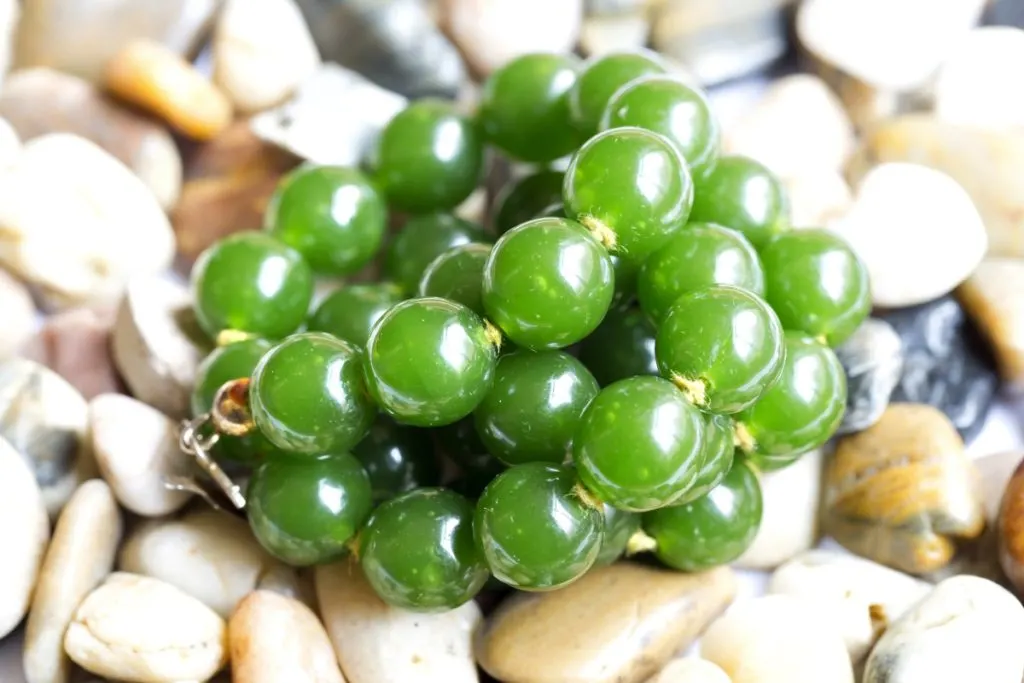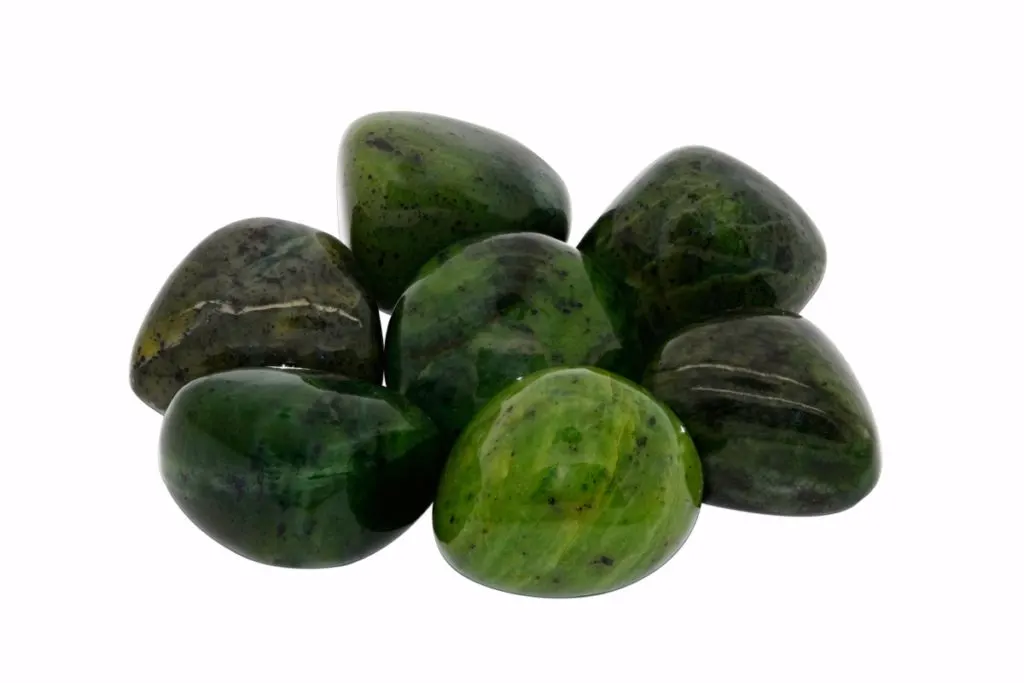As an Amazon Associate, I earn from qualifying purchases with no additional costs for you.
Jade is highly praised for its vivid green color but sometimes results from dyeing. Dyeing, bleaching, and impregnation are the most common methods of jade treatment. Today, we will focus on jade dyeing and shed light on such fundamental questions: how to tell if jade has been dyed, what the reasons for dyeing are, if this treatment is stable, and how much the dyed jade is worth.
Dyed jade is hard to identify. Ideally, dyed jade has its mark on the trade – it is Type C jade. Dyed jade treatment can be spotted under UV light or magnification. The inhomogeneous concentration of dye can be observed under great magnification. Only gemologists can identify dying for sure.
Lavender, orange, and white colors of jade are extremely rare; however, they can be natural! Sometimes, these incredible colors occur as a result of dyeing.
Even more, the coloration of jade is often streaked or mottled, giving jadeite gemstones an interesting visual texture that carvers can use to create imaginative and intriguing effects. Learn how dyeing can be spotted in jade and how to become sure of jade coloration.

If you want to check out the best rock and mineral identification books, you can find them here (Amazon link).
How Can You Tell if Jade Has Been Dyed?
Dyed jade identification is a challenging process for even professional gemologists. Basic gemological methods are usually not enough to tell the treatment for sure.
Further, you will find essential tips to help you understand whether the jade is dyed. However, in the case of jade, it’s always better to ask a gemologist.
Dyed jade should be marked as Type C jade on the trade. To identify treatment, it is necessary to use UV light – dyed zones will glow. Also, dyed jade can be spotted due to the green pigment concentration between natural jade tiny crystals. Beads of jade coated with dye will have chips around the bead’s hole.
Here are a few words regarding why the jade is so severely treated. The reason for jade treatment is its high popularity in Chinese culture.
The demand for jade is exceptionally high and continues to grow each year. Jade is a spiritual stone with significant meaning intricately woven into Chinese culture for thousands of years.
It’s noteworthy that modern gemologists use “jade” as a generic term for nephrite and jadeite minerals. These gems have been linked throughout history.
The term jade has also been applied to several gems, ornamental materials resembling jade, and even some man-made equivalents resembling jadeite and nephrite.
The best jade is jadeite jade. And it’s correct to use jadeite or nephrite jade terms instead of general jade. So pay attention to what the trader calls its material.
The Jade market is a separate world from the colored stone trade. Jade treatment is so standard that it has its classification:
| Jadeite jade types | Treatment type |
|---|---|
| Type A jadeite | Technically, it is natural, but it can be dipped in wax or treated with a surface coating. Wax coating is not considered a treatment as it is a traditional finishing process for jade. |
| Type B jadeite | Bleached and impregnated jadeite. |
| Type C jadeite | Dyed material. |
| Type B+C | A combination of dyed and impregnated material. |
The GIA (one of the most trustworthy gemological labs in the world) reports identifying jade treatments with generic terms like “dyed,” “impregnated,” or “luster-enhanced.”
- Step: Tell if jade is dyed to see the trade labels. If it is Type C jade – it stays that jade is dyed.
- Step: examine jade under magnification. The green pigment used for enhancement tends to concentrate between tiny pale jadeite crystals.
- Step: check the area around the hole of the bead. Inhomogeneous coloration will also be observed in this zone.
- Step: If the jade is coated with green dye (the cheapest way of jade treatment), small chips can be spotted on the zones exposed to mechanical friction (prongs, claws, edge of bezel mounting).
- Step: requires a source of UV light or black light. Dyed zones glow under UV light, while natural untreated jadeite jade stays inert. Please be careful with this method because waxed natural jadeite (not considered treated or dyed) can glow occasionally.
TIP: Because of Jade’s popularity, there is a list of other minerals and materials like glass and plastic to fake natural jade. Find out the main differences between real and fake jade in the article below:
Real vs. Fake Jade: Fucus on These Crucial 5 Differences
What Does Dyed Jade Look Like?
Dyed jade looks identical to untreated material. Methods of jade enhancement have evolved over the centuries. Some signs of dyeing can be occasionally observed. If you can spot just one – jade is treated for sure.
Dyed jade looks absolutely the same as the untreated one. Dyed jade has an apple-green or lush-green color with white and grayish-white veins. Dyed jade has a local concentration of saturated green pigment between the jade crystals, which can be observed under magnification.
Here are the signs of dyed jade:
- Zones of dye concentrations. Dyed jade looks green and originates between pale crystals, while crystals stay white or whitish-green.
- Chips on the surface, around the bead hole, or on the zones in contact with metal.
- Green zones glow under UV light.
BTW: Do you want to know more about rock and mineral identification? The books listed below are the best ones you can find on the internet (Amazon links):
- Smithsonian Handbooks: Rocks & Minerals
- Gemstone & Crystal Properties (Quick Study Home)
- Ultimate Explorer Field Guide: Rocks and Minerals (National Geographic Kids)
Why is Jade Dyed?

Jadeite jade’s three most important qualities are color, transparency, and texture. Dyeing can improve two of them (both color and texture) and significantly increase the price.
Jade is commonly dyed to improve the pale color to the highest valued vivid green and, as a result, to increase the jewelry piece price. The porous structure of natural jade soaks the coloring agent quite well, making the identification of the treatment process complicated.
Dyeing can alter the color of pale or grayish jadeite and, more rarely, nephrite. This is accomplished by adding a green dye to the impregnation material. Lavender jadeite might be treated with dye alone, which can be undetectable.
Carvings and bangles might be partially dyed to imitate the natural variations seen when a highly skilled artisan incorporates those variations into the final design.
Dyeing can introduce orangy brown colors, imitating a boulder’s skin or oxidized outer surface. The result is virtually indistinguishable from the natural coloration of concentrated iron compounds.
A trained gemologist can sometimes detect this treatment using magnification and a hand-held spectroscope, but advanced technologies are necessary to produce the final report regarding the treatment.
TIP: Geodes are other rocks that are often dyed. Find out how to spot dyed geodes in the article below:
How to Tell if a Geode is Dyed: All You Need to Know
What is Dyed Jade Worth?
Dyed jade is far cheaper than natural ones. The price difference can reach four-digit values. That is why it is so important to know how to spot treatment.
The price for dyed jade is the lowest among all other types of treated jade. Depending on the size of the stone and kind of jewelry (be it bangle or carving), the price for dyed jade doesn’t exceed $50, compared to natural jade, where the price per carat (0.2 grams) can be more than $1000.
The most traditional jade piece of jewelry is a bangle (rigid, ring-shaped solid bracelet carved from a solid piece of stone). It’s possible to find a dyed jade bangle for about 15 dollars.
The price for dyed jade is low when the treatment is indicated. It’s crucial to disclose all the treatments fairly.
Is All Jade Dyed?
Not all jade is dyed. There is a lot of high-quality material which doesn’t require color enhancement. Jade is impregnated, bleached, or wax-saturated far more often than dyed. If the jade is called Type C, it is dyed to improve its appearance.
How Long Does Dyed Jade Last?
The dyed jade color (of course, depending on the manufacturer) is relatively stable and can last for years if handled with care.
Exposure to chemicals, household cleaners, or a jeweler’s torch heat can negatively affect jade’s appearance (including artificial coloration) and durability.
How do You Get the Dye Out of Jade?
The dye can be removed from the jade by wiping the stone with a cloth soaked with a solvent like acetone or placing it into a bleaching solution for a few hours. However, we do not recommend you to do this, as the whole piece of jewelry can be spoiled.
Conclusion
Various methods commonly treat Jade. They are impregnation, bleaching, and dyeing. It is pretty challenging even for professionals to spot them.
Dyed jade is marked as Type C jade on the trade.
- To identify treatment, it is necessary to carefully observe the jade under magnification to find zones of pigment concentrations.
- UV light can come in handy while trying to spot dye. Dyed jade can sometimes glow under the black light.
- Also, beads of jade coated by dye will have chips around the bead’s hole.
To conclude the treatment, we highly recommend consulting with professional gemologists.
TIP: Using UV light is necessary when identifying dyed jade. Testing with UV light is also required when trying to identify genuine and fake ambers. Find out more about how to spot phony amber in the article below:
Real vs. Fake Amber: 9 Key Differences & UV Light Testing
